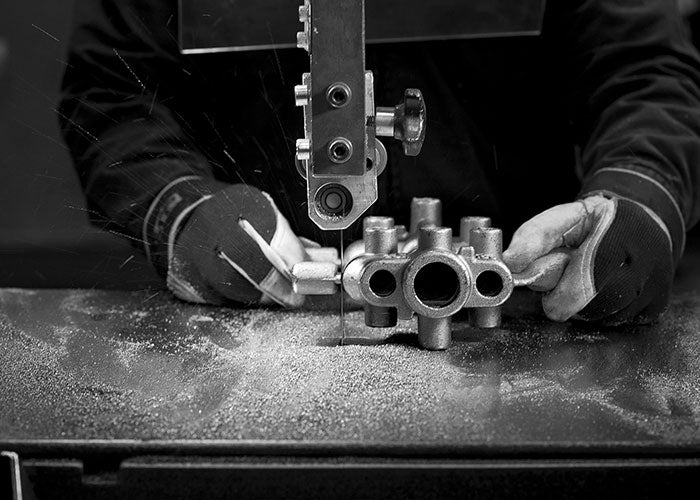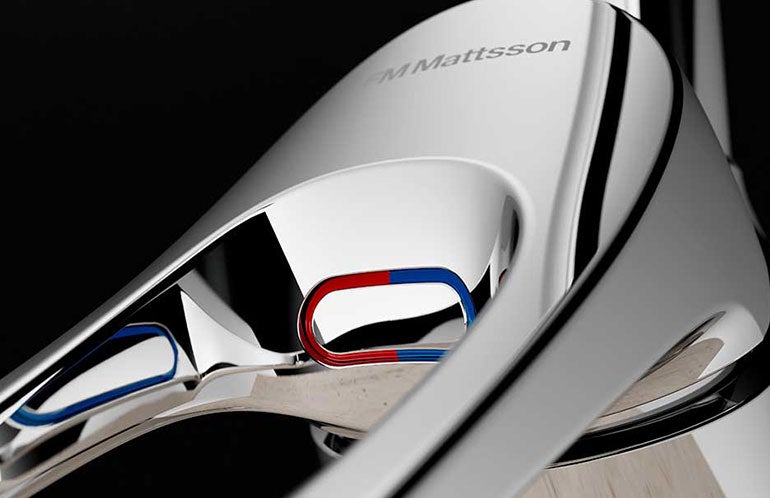Meet Johanna Wallin
– Production Supervisor of FM Mattsson's products.
Since the 19th century, FM Mattsson has been manufacturing faucets/showers in brass - a tradition that means a lot to Mora and us as a company. Even today, most of our products are cast in the factory in the village Östnor, where the love for craftsmanship has always been a central part of daily work.
But what does the manufacturing process look like, and what are the critical steps in the assembly of our products? With the help of Johanna Wallin, the production supervisor in assembly, we will go through all the phases that our faucets/showers go through before they end up in the hands of our customers.
If you want to get in touch with any of our knowledgeable employees, feel free to contact us here.
Can you describe our craftsmanship tradition?
FM Mattsson has a tradition of crafting in brass that dates back to the 19th century. In fact, we cast our first faucet as early as 1876. We at FM Mattsson are very proud of our sustainable products and the fact that we still have production in our factory. We cast almost our mixers, which is truly amazing!
How long does it take to manufacture a mixer?
It takes between six to seven working days, and the process can be divided into the following phases:
Coremaking
From a container located outside the factory, extremely fine quartz sand is transported inside the factory. There, the sand is mixed with binder and hardener. The core mixture is then blown into a heated mold, where it hardens.
Casting in the Casting Cell
The fully automated casting cell was built and designed by our employees in collaboration with a local automation company. With over 100 years of casting experience, we wanted to incorporate our own ideas on how to achieve the best cast. At each pallet of sand cores, there is a camera that monitors the position of the core and detects if it is misaligned. A robot then adjusts based on this information. The casting robot produces 100 to 180 mixers per hour with calm casting. The exact number varies depending on the product. There are two furnaces that cast alternately 20 shots each, and while one is in use, the other is filled with new brass and cleaned. Calm casting requires that when switching between the casting furnaces, we add brass and raise the temperature. When the brass melts, slag forms around it, and before returning to the furnace, the temperature is lowered so that the slag settles on the surface. The brass is pushed up with compressed air (0.3 – 0.5 bar) through a cushion in the furnace.
Riser and Runner Cutting
The risers and runners are cut instead of being sawed off. The cutting force is about 20 tons, and the robot measures the pour ensuring straightness during cutting.
Core Cleaning
The cleaning machine is a blasting machine that processes the castings with small steel beads, causing the sand core to break apart and the sand to flow out of the mixer.
Machining & Component Manufacturing
With our 15 multi-spindle lathes, we produce larger series of up to about 10,000 – 40,000 details. The setup time is approximately 10 – 12 hours. We manufacture around 200 different components here – about 3.2 million pieces per year.
CNC-Machines
With our 11 single-spindle machines, we produce smaller series and more complex components. The setup time is approximately 1 – 2 hours. We manufacture around 2000 different components here – about 2 million pieces per year.
Washing
For washing the machined details, a low-alkaline washing machine is used to remove oil, emulsion, and chips. The machine can be individually adjusted for each basket in terms of rotation or static, rocking, and rinsing times. It has a capacity for about 25 million pieces per year.
Machining (Housings)
In 2014, we automated several of our machines to improve ergonomics and better utilize the machines.
Grinding and Buffing
Grinding primarily takes place in automated cells programmed for each specific product. About 0.7 mm is removed to eliminate any surface imperfections. This is a very hot process, and in some cases, the product can reach temperatures as high as around 500°C. We use various types of abrasive belts – ranging from simpler sandpapers (silicon) to more complex belts containing ceramics. Buffing is mainly done in automated cells. To achieve the optimum result, two types of wax are used – a polishing wax and a gloss wax.
Surface Treatment
The facility applies both nickel and chrome. The parts are placed on a goods rail, which is then picked up by a conveyor. Microcomputer-based optical distance meters are mounted in the ceiling, and with the help of an infrared beam reflected off a mirror on the conveyor, the exact distance to where the conveyor is located can be measured. The conveyor lowers the goods rail into various baths according to the following process:
- Alkaline Degreasing (cleaning of products similar to soap)
- Cathodic Degreasing (same as above but with electricity, where 4 – 10V electricity repels dirt)
- Anodic Degreasing (activates the brass with electricity for nickel, 4 – 10V)
- Decapitation (film remover, environmentally friendly acid that rinses off residues from cathodic degreasing)
- Nickel Plating & Chromium Plating. The details are coated with 10 – 20 µm Ni and approx. 0.1-0.3µm Cr.
Between the different process steps, the goods are rinsed in water. The used rinsing water is purified in the treatment plant before being discharged. The total processing time is around 75 minutes.
Pipe Bending
Cutting/bending of components for, for example, soldering, pipes. (Approximately 600 different components in various volumes).
Pressing
We have 13 different presses for various types of fastening and stamping jobs.
Assembly
Assembly of thermostats and single-lever mixers (sink, wall, laundry), touchless mixers, garden valves. Testing of single-lever kitchen and sink mixers. Most mixers are tested for tightness with air, and some with water. The maximum flow of hot and cold water, shut-off, and external tightness are also checked.
Assembly and Testing of Touchless Mixers
The mixers are tested for tightness, and the electronics are also tested to ensure they function correctly.
Thermostat Testing
Before testing begins, the incoming water temperature is checked. Hot water should have a temperature between 55 and 65°C, and cold water should not be hotter than 15°C. First, the "lock button mode" is calibrated to 39° ± 1°. Once this is approved, the cold and hot water modes are checked. Hot water should have a minimum temperature of 42°, and cold water should have a maximum of 18°. The machine then performs a recheck of the "lock button mode" = 38°C. Finally, the hot water flow (leakage flow) is checked in case of cold water failure, which should not be more than 0.6 liters per minute. During the test process, external tightness, connections, upper parts, etc., are also tested.

Here you can see how the manufacturing process of a mixer takes place.
How many people are involved?
It's hard to say because we work with various types of items concurrently all the time. Approximately six to seven people are involved from the different departments, for example, in creating a mixer body.
What is the most important thing to consider when manufacturing a mixer?
To deliver the right quality.
What makes you most proud to work at FM Mattsson?
All the knowledge that exists here and our fine sustainable products.

